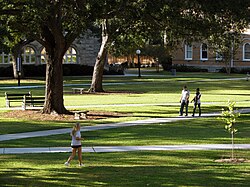Tulane University
 |
|
|
Former names
|
Medical College of Louisiana (1834–1847), University of Louisiana (1847–1884) |
|---|---|
| Motto | Non Sibi Sed Suis (Latin) |
|
Motto in English
|
Not for oneself, but for one's own |
| Type | Private |
| Established | 1834 |
| Endowment | $1.171 billion (2016) |
| President | Michael Fitts |
|
Academic staff
|
1,180 |
| Students | 13,449 |
| Undergraduates | 8,339 |
| Postgraduates | 5,110 |
| Location |
New Orleans, Louisiana, U.S. 29°56′07″N 90°07′22″W / 29.935344°N 90.122687°WCoordinates: 29°56′07″N 90°07′22″W / 29.935344°N 90.122687°W |
| Campus | Urban, 110 acres (0.45 km2) |
| Newspaper | The Tulane Hullabaloo |
| Colors | Olive Green & Sky Blue |
| Athletics |
NCAA Division I – FBS The American |
| Sports | 16 varsity teams |
| Nickname | Green Wave |
| Mascot | Riptide the Pelican |
| Affiliations |
AAU ORAU URA NAICU SURA |
| Website | tulane.edu |
|
Tulane University
|
|

Gibson Quadrangle
|
|
| Location | St. Charles Ave., S. Claiborne, Broadway, and Calhoun Sts., New Orleans, Louisiana |
|---|---|
| Area | 45 acres (18.2 ha) |
| Built | 1834 |
| Architectural style | Renaissance, Romanesque, Modern |
| NRHP Reference # | 78001433 |
| Added to NRHP | March 24, 1978 |
| University rankings | |
|---|---|
| National | |
| ARWU | NR |
| Forbes | 129 |
| U.S. News & World Report | 39 |
| Washington Monthly | 203 |
| Global | |
| ARWU | NR |
| QS | 501-550 |
| Times | 251-300 |
| U.S. News & World Report | 442 |
Tulane University is a private, nonsectarian research university in New Orleans, Louisiana, United States. It was founded as a public medical college in 1834, and became a comprehensive university in 1847. The institution was privatized under the endowments of Paul Tulane and Josephine Louise Newcomb in 1884. Tulane is a member of the Association of American Universities.
The university was founded as the Medical College of Louisiana in 1834 partly as a response to the fears of smallpox, yellow fever, and cholera in the United States. The university became only the second medical school in the South, and the 15th in the United States at the time. In 1847, the state legislature established the school as the University of Louisiana, a public university, and the law department was added to the university. Subsequently, in 1851, the university established its first academic department. The first president chosen for the new university was Francis Lister Hawks, an Episcopalian priest and prominent citizen of New Orleans at the time.
The university was closed from 1861 to 1865 during the American Civil War. After reopening, it went through a period of financial challenges because of an extended agricultural depression in the South which affected the nation's economy. Paul Tulane, owner of a prospering dry goods and clothing business, donated extensive real estate within New Orleans for the support of education. This donation led to the establishment of a Tulane Educational Fund (TEF), whose board of administrators sought to support the University of Louisiana instead of establishing a new university. In response, through the influence of former confederate general Randall Lee Gibson, the Louisiana state legislature transferred control of the University of Louisiana to the administrators of the TEF in 1884. This act created the Tulane University of Louisiana. The university was privatized, and is one of only a few American universities to be converted from a state public institution to a private one.
...
Wikipedia



